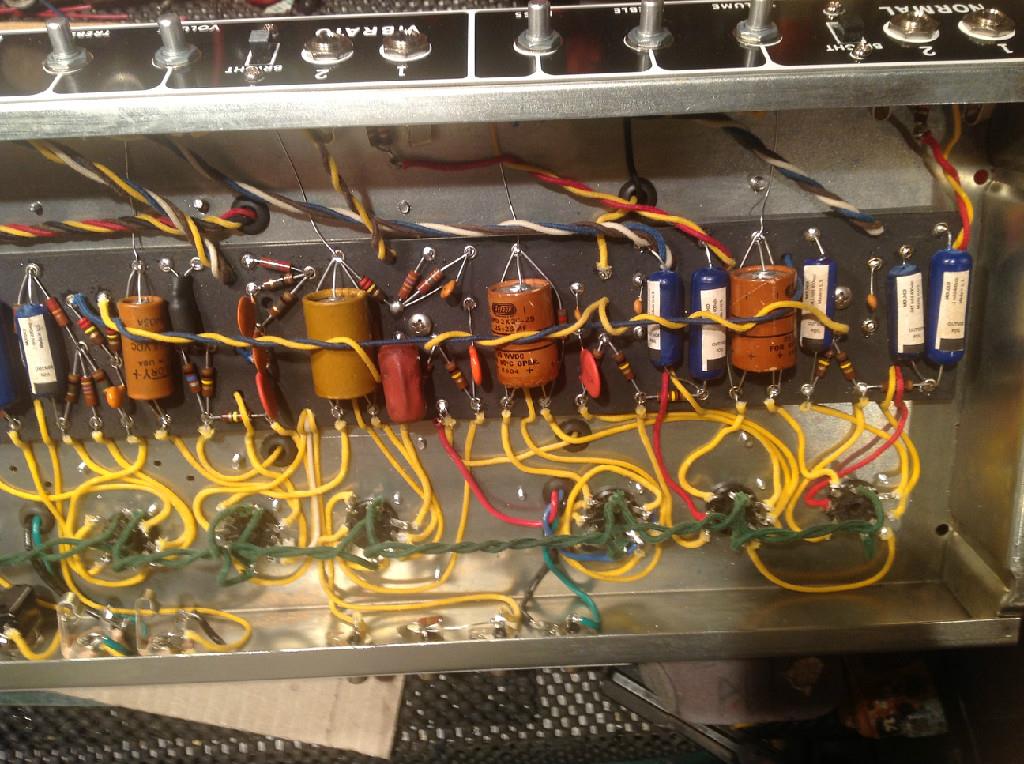
This is a 1964 Fender Vibroverb that I restored
The only original part of the Vibroverb was the speaker. Everything else was reproduced – the chassis, the cabinet, the circuits, everything It is an exact reproduction of the AB763 circuit as it looked in 1964. The 1964 JBL D-130F speaker was re-coned, as there was a bullet hole in the cone. (Long story). I used restored Astron Minimite filter capacitors, and reproduction blue tubular tone capacitors. (Everyone calls them “Paktron”, or “Ajax”, but they were actually may have been made by Mallory). Restoring the dual 25/25 capacitors is fiddly and time-consuming, but rewarding when the finished product is nearly indistinguishable from the original. True, most people are not going to open up the chassis of the amp to look at the circuit, but I know it’s there.
Here’s a photo of the new “old” capacitors during layout on the eyelet board:




Start-up on the bench
Brought the circuit upon the Variac, with a dummy load, everything was fine, all heaters good, Power to the rectifier and bias, and to the caps all within spec. I flipped the Standby switch and was greeted with the HORRIBLE SOUND OF DOOM. Giant farting buzz usually means the Output transformer primaries are out of phase. Sure enough, I switched the Blue and Brown wires to the power tubes, and all was quiet – peaceful and serene as a grassy meadow on a sunny day. So, I got rid of the dummy load and plugged the output into a spare 15″ speaker. Plugged Daphne, my Daphne blue ’63 Stratocaster, into Channel 1. Channel 1 sounded great – perfect Fender tone and just starting to break up with the volume on 4. Channel 2 (vibrato/reverb) not so great – very weak and thin, no gain. I immediately noticed a strange lack of “Z” jumper (it is the solo yellow wire running across the #2 dual 25/25 cap). I added the “Z” jumper and still no joy. Stared at the board for a while until smoke started to come out of the second dual capacitor. At first, I thought this was a fault with my work on the Astron dual cap, but then I noticed that the 1 Meg resistor on the ground side was missing. Voltages were way high on the caps, as well, which might explain the smoke. I replaced the dual cap with a spare, also a reproduction, but this time a Mallory, and stuck in the missing resistor. All better. The two channels match perfectly and sound great. The reverb on channel 2 is lush and, set properly (at around 2.25) it is not overstated. The vibrato had a problem as in there wasn’t any. Again, after board-staring for a couple of minutes, I suspected that the tiny ground jumper from the Opto-isolator bug might be the culprit. Checked continuity, and sure enough, it wasn’t there. I don’t remember being drunk when I soldered this! I stuck the jumper top-side (it’s usually below the board) and had a great vibrato with no “ticking” and no switching noise. This is pretty good considering the ceramic caps and (always suspicious) lead dress.
The photo below shows the “Z” jumper, the replacement Mallory dual cap, the missing resistor, and the vibrato mystery ground. Compare this to the photo of the board at the top of the page.






